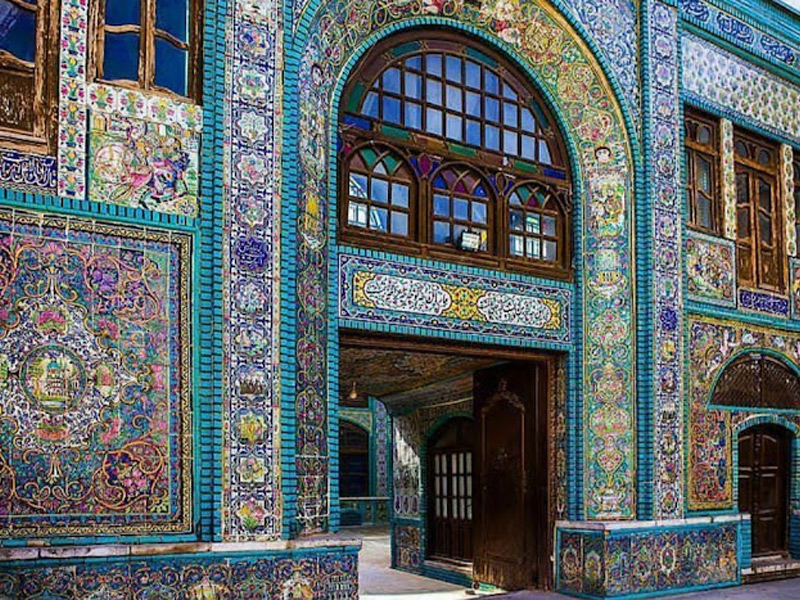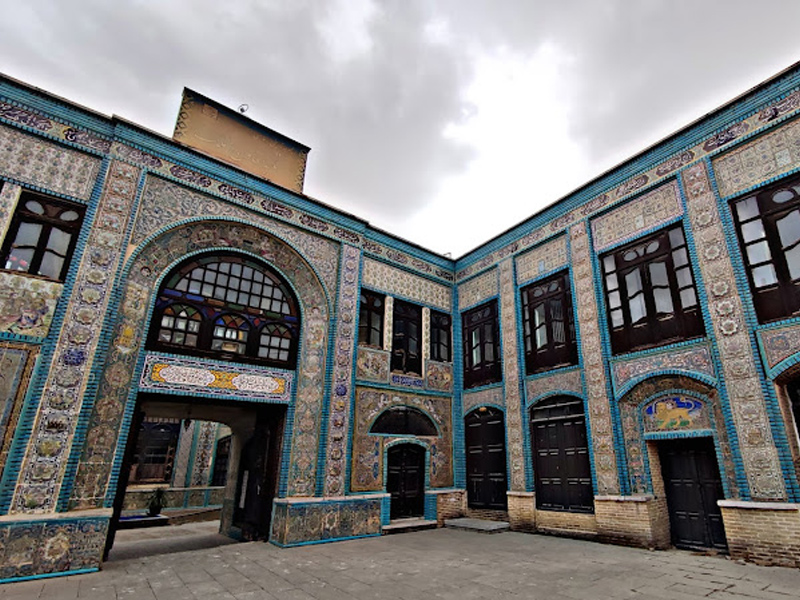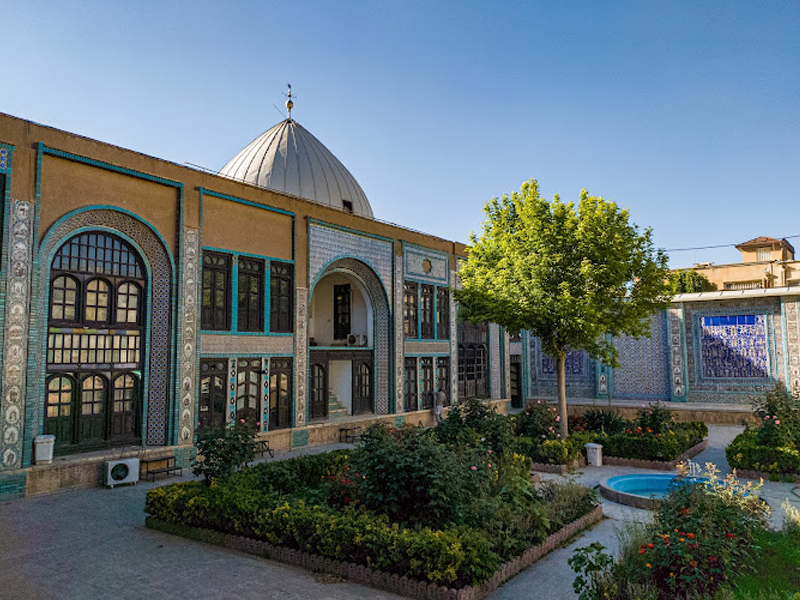Throughout the country of Iran, there are various mausoleums and one of the oldest among them is called Moaven-Ol-Molk’s Mausoleum, located in the city of Kermanshah. It is known as the largest miniature mausoleum in the world and is unparalleled in terms of its magnificent architecture and tile work. By introducing this Mausoleum as one of the valuable historical and religious sites and one of the tourist attractions of Kermanshah province, let’s take a virtual tour of this remarkable structure:
Book Iran Air flights from London to Tehran and Tehran to London with Eligasht UK:
Moaven-Ol-Molk’s Mausoleum
Moaven-Ol-Molk is the name of a mausoleum in the city of Kermanshah, which was built 114 years ago during the Qajar era. This mausoleum, located on the old Abshuran Street, consists of several sections, including Hosseiniyeh, Abbasiyeh, and Zeinabiyeh. The Hosseiniyeh section of this mausoleum was built in 1281 AH (Islamic calendar) to hold mourning ceremonies for the martyrdom of Imam Hussein. It was put into use one year after its construction. In 1282 AH, the Constitutionalists (supporters of the Constitutional Revolution) closed down this place and set it on fire, causing its destruction. A series of unfortunate events followed, and even the builder of the structure was assassinated.
All these incidents caused the reconstruction of the mausoleum to be delayed and it was restored several years later. After the restoration, the building opposite was purchased to add other sections such as Zeinabiyeh and Abbasiyeh to it. Hassan Kham was the person who restored Moaven-Ol-Molk’s Mausoleum.
After the Qajar government was transformed into Pahlavi, rumors of demolishing the building were heard until a person named Seyyed Mohammad Meybodi suggested that the Abbasiyeh section be transformed into an Islamic sciences school to prevent its destruction. As a result, the Abbasiyeh section served as a school for 30 years.
Architecture of Moaven-Ol-Molk’s Mausoleum
Since this mausoleum is located in a depression, you have to descend a few steps to enter it. After entering the main courtyard, you enter the main section. This place has 3 entrances, and the main entrance is located on the former Abshuran Street (Haddad Adel today). In the past, these doors were built to facilitate the orderly entry of mourners. One of these doors is in the southern section and one in the northern section, and currently, 2 doors are closed while only the main one is open.
One of the most authentic reasons for the fame of Moaven-Ol-Molk’s Mausoleum is its unique tile work, which is truly exceptional in terms of the colors, images used, and size and dimensions. Many people believe that tiles are the main reason for the mausoleum’s name, but this is not the case. One should also consider its historical, cultural, and architectural significance.

Tile work of Moaven-Ol-Molk’s Mausoleum
As mentioned above, these tiles are adorned with special patterns, and colors, and some of them are raised tiles, while others are known as seven-colored tiles. The patterns depicted on them are national, epic, and religious literary stories.
After descending the entrance stairs, you enter the courtyard of Moaven-Ol-Molk’s Mausoleum, where there is a water fountain on its right side. This fountain is built in a pentagonal shape and portrays scenes of Hazrat Sakineh’s plea for water. After passing the fountain, you reach the underground area, which used to be the connecting path between the alleys.
The Hosseiniyeh of this mausoleum has a small and pleasant courtyard surrounded by tall walls, with two-story rooms surrounding this courtyard. The Hosseiniyeh, as mentioned, served as a venue for mourning and lamentation ceremonies, mainly for men, while women mourned in a separate location, which will be discussed later.
How to get to Moaven-Ol-Molk’s Mausoleum
To reach this place, make your way to Azadi Square, located in the heart of Kermanshah city. From there, head south and continue for approximately one kilometer until you reach the intersection of Navvab Safavi and Modarres Streets. Both of these streets will lead you directly to the mausoleum. Alternatively, if you find yourself in other areas of the city, you can easily access Moaven-Ol-Molk’s Mausoleum by walking a short distance from the well-known Shahnaz or Vaziri Squares.
Other attractions of Moaven-Ol-Molk’s Mausoleum
Moaven-Ol-Molk’s Mausoleum is home to two fascinating museums: the Anthropology Museum and the Clothing and Jewelry Museum.
The Anthropology Museum, situated in the southern part of this place, was established in May 1990. Spanning a 200-square-meter hall, this museum features 29 showcases displaying a wide array of artifacts, including ancient objects, Kermanshah handicrafts, traditional clothing, and more. With its cultural and social themes, visitors can explore items such as agricultural tools, livestock farming equipment, hunting artifacts, traditional weaving, musical instruments, writing instruments, lighting fixtures, as well as textiles, and traditional and local attire.
The Clothing and Jewelry Museum, located in the Abbasiyeh section of the mausoleum, was founded in 2004. Showcasing the rich diversity of clothing and jewelry from various regions within Kermanshah province, this museum captures the essence of local fashion. Within its 200-square-meter hall, visitors can marvel at the traditional garments worn by people from Harsin, Qasr-e Shirin, Gilan Gharb, Paveh, and other cities in Kermanshah province.
Related post
Anahita Temple, Kermanshah Province
Bisotun Historical Site, a UNESCO World Heritage Site
Final words
Moaven-Ol-Molk’s Mausoleum stands as a testament to the rich history and cultural heritage of Iran. Stepping into this place, visitors are greeted by the architectural splendor of the complex. The intricate design, adorned with exquisite details, creates a captivating atmosphere that transports visitors back in time. Moaven-Ol-Molk’s Mausoleum is not only a site of historical importance but also a place of reverence and reflection. It serves as a reminder of the individuals who have shaped the course of Iranian history and invites visitors to delve into the rich tapestry of the past. For those who appreciate history, architecture, and cultural exploration, a visit to Moaven-Ol-Molk’s Mausoleum is an opportunity to immerse oneself in the legacy of a remarkable figure and gain a deeper understanding of Iran’s captivating past.
FAQ
1- Where is Moaven-Ol-Molk’s Mausoleum located?
It is located in Kermanshah, Iran.
2- Who was Moaven-Ol-Molk?
Moaven-Ol-Molk was a prominent Iranian politician and military leader during the Qajar era. He served as the deputy prime minister and played a significant role in the political landscape of his time.
3- What is the significance of Moaven-Ol-Molk’s Mausoleum?
Moaven-Ol-Molk’s Mausoleum holds historical and cultural significance as it commemorates the life and contributions of a prominent figure in Iran’s history. It serves as a tribute to his legacy and provides insights into the political and social context of the Qajar period.
4- What can visitors expect to see at Moaven-Ol-Molk’s Mausoleum?
Visitors to Moaven-Ol-Molk’s Mausoleum can explore the architectural beauty of the complex, which includes the Hosseiniyeh, Zeinabiyeh, and Abbasiyeh sections. They can view paintings depicting events of Ashura and scenes from battles, as well as visit the Kermanshah Clothing and Jewelry Museum located in the Abbasiyeh section.

